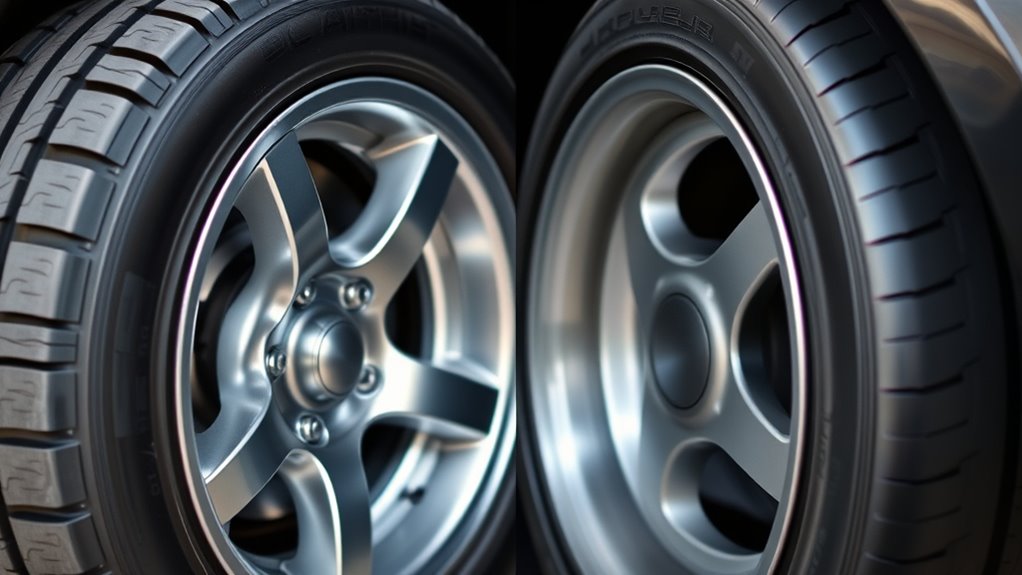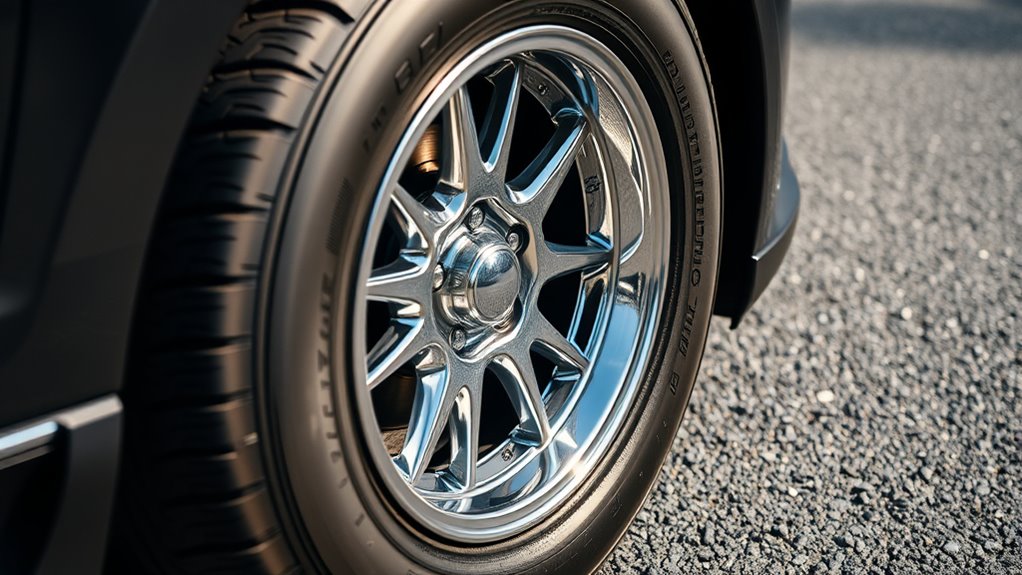Matching your tire width to rim width is essential for safe, smooth riding and longer tire life. Proper pairing ensures the tire seats correctly, distributes forces evenly, and prevents issues like sidewall stress, cracks, or leaks. Using the right combination also improves handling and contact patch, enhancing traction and safety. If you want to learn how to choose the best size match for your setup, keep exploring for key tips and expert guidance.
Key Takeaways
- Match tire width to rim width according to manufacturer guidelines for optimal performance and safety.
- Proper pairing ensures even tire wear, better handling, and reduces the risk of bead leaks and blowouts.
- Rim material influences compatibility; select tire widths suitable for aluminum, steel, or carbon fiber rims.
- Correct tire and rim pairing maintains proper contact patch shape, enhancing grip and cornering stability.
- Following recommended width ranges prevents sidewall stress, cracks, and premature tire deterioration.

Choosing the right tire width and rim width pairing is essential for peak performance and safety. When you select the appropriate combination, you not only improve ride quality but also guarantee your tires perform at their best over their lifespan. One critical aspect to consider is tire durability. A well-matched pair minimizes uneven wear and reduces the risk of blowouts or premature deterioration. If your tire is too narrow for the rim, it can cause excessive stress on the sidewalls, leading to cracks or faster wear. Conversely, a tire that’s too wide may not seat properly, resulting in bead leaks or inconsistent contact with the road. Proper pairing helps distribute forces evenly, maintaining tire integrity and longevity. Ensuring proper tire durability also contributes to a safer and more reliable ride over time.
Another vital factor is rim material compatibility. Rims come in various materials, including aluminum, carbon fiber, and steel, each with different flex characteristics and thermal properties. When you match the correct tire width with a compatible rim material, you enhance overall safety and performance. For instance, some rim materials handle wider tires better due to their strength and flexibility, reducing the risk of deformation under load. Additionally, the compatibility influences how well the tire bead seats on the rim, which affects inflation stability and sealing quality. Ensuring your tire width aligns with the rim material’s specifications prevents issues like bead slippage or air leaks, keeping your ride smooth and secure.
It’s also worth noting that rim width influences the tire’s shape and contact patch. A narrower rim paired with a wide tire can cause the sidewalls to roll outward, reducing grip and cornering stability. On the other hand, a wider rim with a narrow tire might result in an overly rounded profile that diminishes traction. When you consider the tire and rim width pairing, you should refer to manufacturer guidelines, which specify the optimal ranges for each rim material and size. These recommendations help you avoid mismatched setups that compromise handling, tire wear, and safety.
Frequently Asked Questions
How Does Tire Width Affect Vehicle Handling?
You’ll notice that wider tires can improve handling by increasing grip, especially in turns, but they also tend to reduce fuel efficiency due to higher rolling resistance. Wider tires may require adjustments in tire pressure to optimize performance and safety. If you choose narrower tires, your vehicle might be more efficient and easier to control on wet or slippery roads. Always consider how tire width impacts handling, fuel economy, and safety for the best driving experience.
Can I Mix Different Rim Widths on the Same Vehicle?
Yes, you can mix different rim widths on the same vehicle, but it’s not ideal. Different rim widths affect tire pressure and grip, which can impact handling and safety. Rim material also matters; alloy rims handle differently than steel. Always check tire pressure and verify the tires fit properly on each rim. For the best results, stick to recommended rim widths and consult your vehicle’s manual or a professional.
What Are the Safety Risks of Improper Tire and Rim Pairing?
If you pair the wrong tire with your rim, you risk compromised tire pressure and rim material damage. An improper fit can cause uneven wear, blowouts, or rim deformation, especially if the rim material isn’t compatible with the tire’s width. This increases safety risks like loss of control or accidents. Always guarantee your tire and rim pairing follows manufacturer guidelines to maintain ideal safety and performance.
How Does Rim Width Influence Tire Wear?
When you choose a rim width that’s too narrow or wide for your tire, you might notice uneven tire wear over time. This happens because improper pairing causes tire deformation, putting extra stress on the sidewalls, and can reduce rim stability. As a result, your tire’s life shortens, and handling feels unpredictable. To keep things smooth and safe, pick a rim width that properly matches your tire for balanced wear and ideal performance.
Are Wider Rims Suitable for All Vehicle Types?
Wider rims aren’t suitable for all vehicle types, especially those designed for narrower wheels. They can enhance wheel aesthetic and improve handling, but they may also increase cost implications due to higher priced tires and rims. You should consider your vehicle’s compatibility and intended use before opting for wider rims. If you’re after a sporty look and better performance, wider rims can be a good choice, but they aren’t ideal for every vehicle.
Conclusion
Choosing the right tire and rim pairing guarantees ideal performance and safety. When you match the correct widths, you improve handling, comfort, and wear life. Are you willing to compromise your ride’s quality by ignoring these details? Remember, taking the time to select the proper pairing isn’t just about convenience—it’s about making every drive safer and more enjoyable. So, why settle for less when the right fit can make all the difference?








